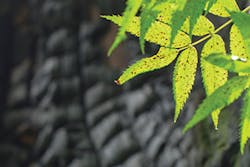In the wild expanses of North America, specialists recognize that fire plays an important role in the forest ecosystem. Sometimes a forest cannot live without it, and often fire can’t be avoided. In fact, certain fire-adapted species of plants require the heat of a wildfire to spur germination. In some cases, fire cannot be controlled, and in some instances the best thing to do about it, experts say, is to watch the spectacle from a respectable distance with an eye toward safe evacuation routes.
When a forest and human habitation come into close proximity, the struggle over fire takes on the character of a double-edged sword. Nonetheless, experts agree that the hazards fire represents do not end when the flames are extinguished. Chief among these hazards in the western United States, where wildfires are among the dominant natural land-shaping events, is the danger of erosion.
In the wild expanses of North America, specialists recognize that fire plays an important role in the forest ecosystem. Sometimes a forest cannot live without it, and often fire can’t be avoided. In fact, certain fire-adapted species of plants require the heat of a wildfire to spur germination. In some cases, fire cannot be controlled, and in some instances the best thing to do about it, experts say, is to watch the spectacle from a respectable distance with an eye toward safe evacuation routes.
When a forest and human habitation come into close proximity, the struggle over fire takes on the character of a double-edged sword. Nonetheless, experts agree that the hazards fire represents do not end when the flames are extinguished. Chief among these hazards in the western United States, where wildfires are among the dominant natural land-shaping events, is the danger of erosion.
[text_ad]
Although wild-land fires have the potential to burn anywhere, they don’t have the same impact everywhere, says Sam Lindblom, director of land management for The Nature Conservancy, Virginia. Lindblom says he “spends a lot of time thinking about fire.” The history of fire, he says, mirrors the history of the North American continent: Not only did fires erupt regularly throughout the continent before human intervention, but once humans arrived in North America fire became a valuable tool. The original inhabitants of the continent used wildfires intentionally, “for many purposes,” notes Lindblom. “They used it to clear routes for travel, and to aid in hunting by treating the ground to create attractive areas for the bison and other animals to graze. They used it to clear land for agriculture. They used it in warfare and for defensive purposes.” Subsequent waves of settlers moving westward from the crowded eastern cities of the 19th century United States also used wild-land fire extensively, as a tool to quickly clear land for settlement and agriculture. Lindblom says, however, that in the late 1800s, “campaigns were started to reduce the use of fire.” In the early 1900s, after a series of dry years and a spate of severe wildfires, “a whole series of policies were adopted restricting the use of fire and focusing on rapidly extinguishing every wildfire, whether it was caused by nature or man.”
These policies included what came to be known as the “10 a.m. policy,” a rule holding that all fires must be extinguished before 10 a.m. the following day. “That has led up to the situation we have now, where we have the buildup of dangerous fuels,” says Lindblom. It has since been recognized that fire is a natural part of healthy wild-land ecosystems, and recently the pendulum has begun to swing back toward allowing many natural fires to burn. Yet the debate continues. “Fire policy in the United States has been evolving since the beginning; just when we think we know something, we learn something new.”
Although erosion is one of the dramatic problems associated with the aftermath of wildfire, severe erosion is in fact a rarity that depends upon conditions being just right, he notes. “It’s a problem in the most severely drought-stricken areas, only after the hottest and most severe fires,” says Lindblom, and even then is dependent on the slope, soil, and, most importantly, on precipitation.
To illustrate the diverse nature of fire’s aftermath, he says, “I’ve never heard of severe erosion caused by a fire happening in the East. The plant systems there hold more moisture, the plants are more productive, and vegetated areas tend to grow back more quickly.”
However, there are a lot of places in the West where fire-induced erosion and landslide risks do loom. During one week in early July 2015, there were 39 major wildfires burning simultaneously in the United States, each affecting 100 acres or more. Most of them were in the Western states. Meanwhile, a years-long drought has taken hold in those same Western states, which, coupled with decades of fire prevention efforts, have burdened many formerly healthy forest tracts with dense, dry underbrush, creating the ideal conditions for powerful infernos hot enough to turn the soil into a sterile hydrophobic crust. Combined with harsh episodic rainfall events that are predicted to intensify with climate change, these conditions set the stage for major post-fire erosion. Even with this horror show of worst-case scenarios, experts usually recommend erosion control measures and treatments for only the small fraction of burned areas that adjoin urban areas, residences, or infrastructure—which nonetheless accounts for vast acreage.
[text_ad use_post='27664']
Just as all of these fires affect different landscapes, burn with varying intensities, and threaten different assets, there are differing approaches to handling the aftermath of each newly fire-scarred landscape. Fortunately, there are a variety of viable solutions to meet the many peculiar situations that may arise in the wake of severe fire.
What science knows is that different ecosystems recover at varying rates, that the recovery process takes time, and that during that time the ground must hold until the first generation of plants establishes itself in order for the cycle to renew. Erosion control measures can play a vital role in providing that window of time when nature might need little help.
Although wild-land fires have the potential to burn anywhere, they don’t have the same impact everywhere, says Sam Lindblom, director of land management for The Nature Conservancy, Virginia. Lindblom says he “spends a lot of time thinking about fire.” The history of fire, he says, mirrors the history of the North American continent: Not only did fires erupt regularly throughout the continent before human intervention, but once humans arrived in North America fire became a valuable tool. The original inhabitants of the continent used wildfires intentionally, “for many purposes,” notes Lindblom. “They used it to clear routes for travel, and to aid in hunting by treating the ground to create attractive areas for the bison and other animals to graze. They used it to clear land for agriculture. They used it in warfare and for defensive purposes.” Subsequent waves of settlers moving westward from the crowded eastern cities of the 19th century United States also used wild-land fire extensively, as a tool to quickly clear land for settlement and agriculture. Lindblom says, however, that in the late 1800s, “campaigns were started to reduce the use of fire.” In the early 1900s, after a series of dry years and a spate of severe wildfires, “a whole series of policies were adopted restricting the use of fire and focusing on rapidly extinguishing every wildfire, whether it was caused by nature or man.”
These policies included what came to be known as the “10 a.m. policy,” a rule holding that all fires must be extinguished before 10 a.m. the following day. “That has led up to the situation we have now, where we have the buildup of dangerous fuels,” says Lindblom. It has since been recognized that fire is a natural part of healthy wild-land ecosystems, and recently the pendulum has begun to swing back toward allowing many natural fires to burn. Yet the debate continues. “Fire policy in the United States has been evolving since the beginning; just when we think we know something, we learn something new.”
Although erosion is one of the dramatic problems associated with the aftermath of wildfire, severe erosion is in fact a rarity that depends upon conditions being just right, he notes. “It’s a problem in the most severely drought-stricken areas, only after the hottest and most severe fires,” says Lindblom, and even then is dependent on the slope, soil, and, most importantly, on precipitation.
To illustrate the diverse nature of fire’s aftermath, he says, “I’ve never heard of severe erosion caused by a fire happening in the East. The plant systems there hold more moisture, the plants are more productive, and vegetated areas tend to grow back more quickly.”
However, there are a lot of places in the West where fire-induced erosion and landslide risks do loom. During one week in early July 2015, there were 39 major wildfires burning simultaneously in the United States, each affecting 100 acres or more. Most of them were in the Western states. Meanwhile, a years-long drought has taken hold in those same Western states, which, coupled with decades of fire prevention efforts, have burdened many formerly healthy forest tracts with dense, dry underbrush, creating the ideal conditions for powerful infernos hot enough to turn the soil into a sterile hydrophobic crust. Combined with harsh episodic rainfall events that are predicted to intensify with climate change, these conditions set the stage for major post-fire erosion. Even with this horror show of worst-case scenarios, experts usually recommend erosion control measures and treatments for only the small fraction of burned areas that adjoin urban areas, residences, or infrastructure—which nonetheless accounts for vast acreage.
Just as all of these fires affect different landscapes, burn with varying intensities, and threaten different assets, there are differing approaches to handling the aftermath of each newly fire-scarred landscape. Fortunately, there are a variety of viable solutions to meet the many peculiar situations that may arise in the wake of severe fire.
What science knows is that different ecosystems recover at varying rates, that the recovery process takes time, and that during that time the ground must hold until the first generation of plants establishes itself in order for the cycle to renew. Erosion control measures can play a vital role in providing that window of time when nature might need little help.


